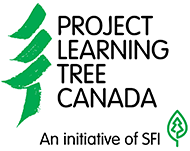Silviculture Forester – Green Jobs Video Series
Andrée Morneault is a Silviculture Forester with Nipissing Forest Resource Management (an SFI-certified company). Silviculture Foresters are responsible for forest regeneration – making sure the trees grow back healthy and strong!
In this video, Lacey learns from Andrée how to find the best pine cones to grow new trees, how to extract their seeds, and she drives a massive skidder through the forest!
Chapters:
0:00 – Episode Introduction
0:32 – Introduction to Andrée
1:04 – Chapter 1: Education
2:35 – Chapter 2: Andrée’s Journey
3:36 – Chapter 3: Andrée’s Green Job
6:20 – Chapter 4: Why It Matters
See photos from behind the scenes
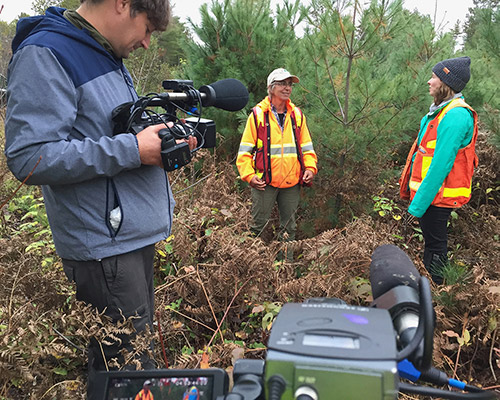
Andrée and Lacey filming a scene together. |
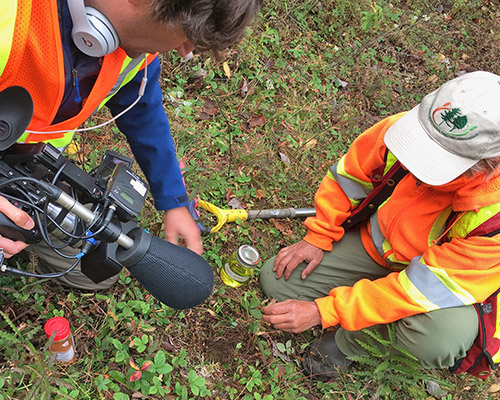
Andrée shoots a scene involving planting an acorn with wolf urine to stop animals from digging it up. |
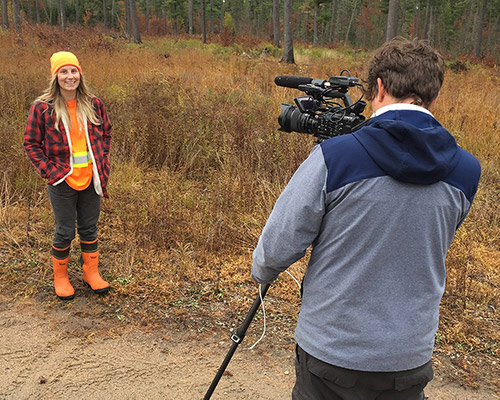
Amy recording her speaking part for the mentorship segment of the video. |
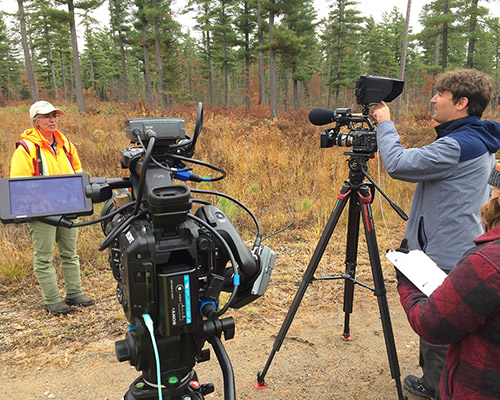
Andrée shoots a scene for her Silviculture Forester Green jobs video. |
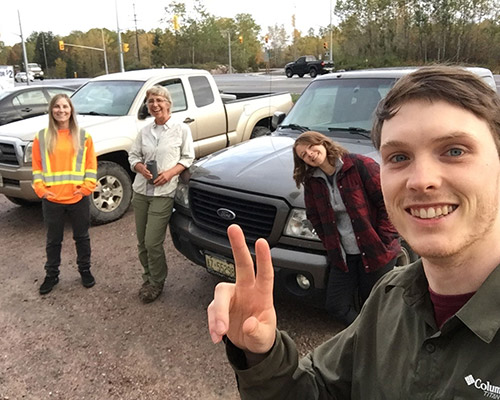
The crew takes a break while shooting the Silviculture Forester Green Jobs video with Andrée Morneau. |
Read the transcript of the video
Lacey
On this episode of PLT Canada’s Green Jobs, we try to solve the mystery of how do you get from this … to this? PLT Canada’s green jobs is taking you all over Canada to explore jobs that are unique, fun, and most importantly, make a difference for our environment and in our communities.
Lacey
When I was an intern, working for the Ministry of natural resources and forestry, fresh out of university, my mentor introduced me to Andrée who was doing research on oak regeneration at the time. She was doing all this weird stuff like seeing if wolf urine would deter predation on acorns, basically stuff that was blowing my mind. I learned so much after just a few short days with her, so I’m really excited to be back in the woods with Andrée to share what goes on in her brain with all of you.
Lacey
If you want to become a forester, you should take courses like biology, social science, and math in high school. In university, taking an accredited forestry program is the most direct route. After you graduate, you’ll get relevant experience in the field and then apply to become a registered professional forester. Foresters are a regulated profession, like nurses and engineers. Just as Andrée was one of my first mentors, she’s continued to mentor up and coming foresters like Amy, that’s one of the most rewarding things you can do as a registered professional forester. Pass on your knowledge and experience to the next generation. PLT Canada has a green mentors program that matches mentees and mentors across Canada.
Amy Chadwick
My name is Amy Chadwick and I recently completed an internship with Nipissing Forest resource management and this was funded by PLT Canada. I had Andrée Morneault as a mentor, and it was awesome. She’s extremely knowledgeable about silviculture, and she was able to teach me so much and a lot of things that I didn’t know.
Andrée
Definitely a feasting zone here … Squirrels!
Lacey
Seeing Andrée training Amy, as she’s entering her career really made me reflect back on that time for me, and you know, you’re just like a sponge absorbing all this knowledge and who better to spend that time with than Andrée.
Andrée
My name is Andrée Morneault. I work as a silviculture forester for Nipissing Forest Resource Management. I grew up as an army brat, my father was in the army. So we moved around a lot when I was a kid, and I really didn’t know what I wanted to do with my life. At some point or another, you got to make a decision. So I decided I wanted to be a farmer. I studied agriculture and plant science. I was working as a gardener on the west side of Montreal. my husband and I wanted to buy a sailboat and one day he said, I’m gonna go tree planting. And with whatever I make, we’ll use that to buy a sailboat. So he went out into the trees for 10 weeks and came back with $2,000 and lots of stories. But he was all worried about the trees saying, “Oh, my God, will they survive?” So I was like, “Oh my God, that’s such an issue.” I want to help solve that problem. And so I went and did a master’s in forestry. And then I got a job in forestry and I never looked back. So silviculture is the growing of trees. We grow trees for a bunch of reasons. There’s the economic reasons, so we grow trees in order to have wood products. There’s the ecological reasons to make sure that there’s habitat for wildlife. And then the third reason would be social reasons people go out canoeing and fishing and hunting and so on and so forth. And so it’s important to have a healthy forest for them to go recreate in.
Andrée
Nipissing Forest is certified under the sustainable forestry initiative or SFI. It’s an independent body that makes sure that we’re doing a good job. They have criteria that we need to follow. This is really important because that way the customers who are buying the wood know that that comes from the sustainably managed forest. For all our trees we need to collect seed a white pine produces seed every three to five years. You want to collect in a bumper year, so when there’s a lot of cones because there’ll be a lot healthier, that means that there was a lot of pollen flow, the genetics are going to be great, and that the cones are gonna be full of seeds. So there’s another job in forestry, it is collecting cones. And so the binoculars are very important for that, because it’s really hard to see, these trees are really tall, so you have to look at them closely. So you would look around and you would check and see what’s going on at the tops. squirrels are your friends when it comes to cone collection, because they’re the ones who cut the cones off the trees.
Lacey
So I have to think like a squirrel to find the cash of where they’ve hid them all for the winter. So I want to stay dry when I’m snacking. Looking under a log – Oh there’s a bunch! Excellent.
Andrée
When you find your cones, then you want to know if they’re good quality. So to test if they’re good, we have this thing here, I call it the Guillotine. So you just sort of place it in here and you got to watch out this knife is really sharp.
Lacey
You could also use this to cut your bag at lunch.
Andrée
So when you put it in, you make sure it’s all lined up. So you actually cut right down the middle of the cone. Give it a big squish! And then when it’s open, then you can look and you can see the seeds inside. Okay, so here, you want to count from 6,7,8,9. And you want at least eight for it to be a good cone. So that’s the idea. So you just slice a bunch of cones, you have good quality, then you can start picking.
Lacey
So let’s play that out a little bit. Someone is here collecting the seeds from these trees. They go to the nursery, which then comes back to you.
Andrée
Yes
Lacey
And that’s what you’ve planted here.
Andrée
That’s right, exactly.
Lacey
That’s pretty neat.
Andrée
So a silviculture forester is essentially responsible to regenerate the forest after it’s been harvested or after it’s been killed by a fire, for example, or by insects. One of the examples would be if you go in and do a harvest operation and you harvest pine, you want to make sure you get pine back because there’s a lot of species that rely on that forest type. As a Silviculture Forester, we ensure that that forest comes back to the species that it needs to come back to.
Lacey
Foresters balance ecological, social and economic values. They gather information, predict and identify problems and come up with solutions to make sure that forests are managed sustainably. Some might even call them the caretakers of the forest.
Andrée
When we’re harvesting, we follow guidelines provided by the government and one of the main guidelines is to emulate natural disturbances. So we’ll manage the forest in different ways depending on the species that are there and what natural disturbance would have got them there if we weren’t in there harvesting. So the white pine forests, its natural disturbance regime is moderate intensity fires. When we look at a moderate intensity fire, we see that it burns off the forest floor right down to the mineral soil if it gets hot enough. And then the other thing that a fire does is it kills the understory vegetation, just temporarily though, everything sort of comes back after. And so when we’re managing the pine forests, we also want to make sure we reduce that vegetation because that will be competing with the new pine. And so we try to emulate that using machinery. So we have a skidder, it’s basically a big machine and on the back it has these two wheels with three paddles. The main purpose of that equipment is to expose the mineral soil so that when the seeds come down, they land in an area where they can grow. So this skidder driver, this is one of those forestry jobs. If you want to get into the mechanical site preparation world, it’s definitely available as a job. And as Lacey probably experienced, it’s quite a ride. It’s bumpy and jumpy and noisy, you know, avoiding the trees and running over the ones you need to. Lacey did a great job in that, it’s something I wouldn’t have tried.
Lacey
I was pumped to drive the skidder. I’ve always wanted to try one. I didn’t feel nervous. “This is Awesome!”
It was just interesting to feel how this giant machine was reacting as I was running over things. It was a lot smoother than I was expecting. Oh my god. That’s a little bit scary.
Andrée
So yeah, this is uh, this is interesting. With white pine, we manage it using the shelterwood system. And so we retain the biggest and best trees to produce lots of cones to get natural regeneration, but we can’t guarantee we’re going to get seeds every year and so to make sure that we actually get white pine growing here we plant and so this is a planted tree here, it was planted two years ago. But we were really fortunate in that we got a really good seed year at the same year and now we have a bunch of natural regeneration so you can see the difference in size. So we plant it to make sure that things go well.
You can see how much bigger it is. So when all this vegetation competition comes in, these guys have an advantage. But these are definitely a bonus. And we love seeing that! These ones are white pine, these three, and this one’s a red pine. And to me, they look very different, to you, they probably look the same. But if you study forestry, you’ll be able to tell the difference too.
Andrée
I really love my job, I love being outside. I love watching things grow. It’s just an ongoing learning process. I feel the more I learn the more I want to learn, the less I know, like there’s always something to learn about. Most of the time, I feel at peace. I really, really enjoy the sounds, right now we can hear the crickets, the birds, the squirrels, when the wind blows through the white pine is just music.
Lacey
I think one of the things that impresses me the most about Andrée is how much she cares about regenerating these forests. You can see it in her face when she’s showing you the work that’s been done in these forests. It really matters to her personally and I can say that, you know, if she’s looking after a forest, it’s being well cared for. Thanks so much for joining us today in the Nipissing Forest. As we learned all things white pine from Andrée the Silvicultural Forester.
See you next time on PLT Canada’s Green Jobs. If you would like to work experience in the forest and conservation sector, or we’d like to learn about our mentorship program and Career Resources, visit PLT canada.org.
This episode was filmed within the Robinson-Huron and Williams Treaties, which are home to the Anishinaabe and Algonquin Peoples.
Back to all videos
